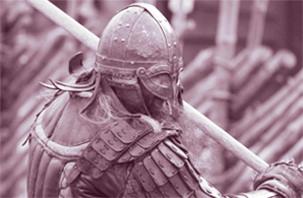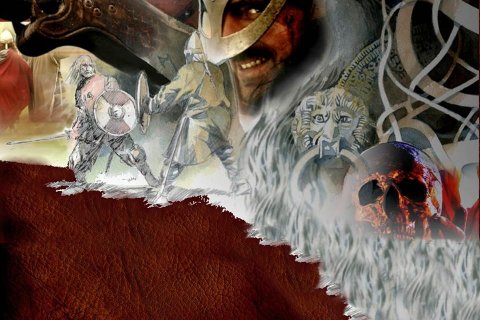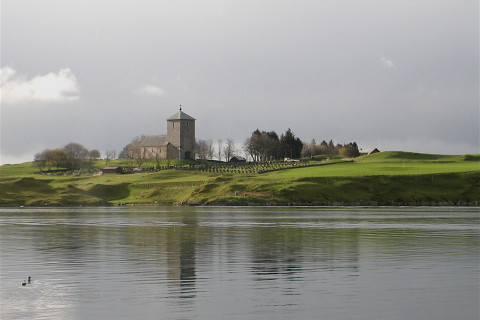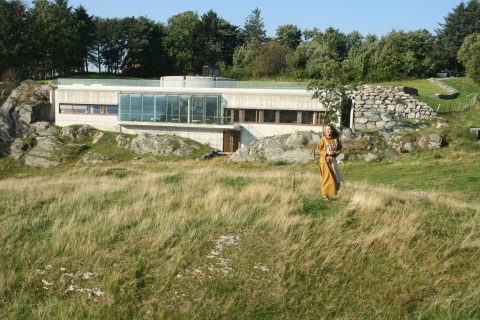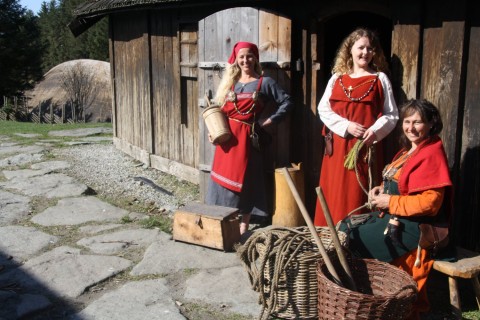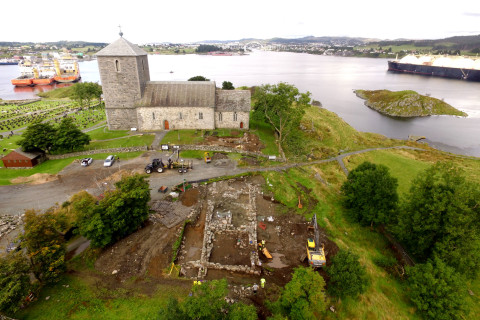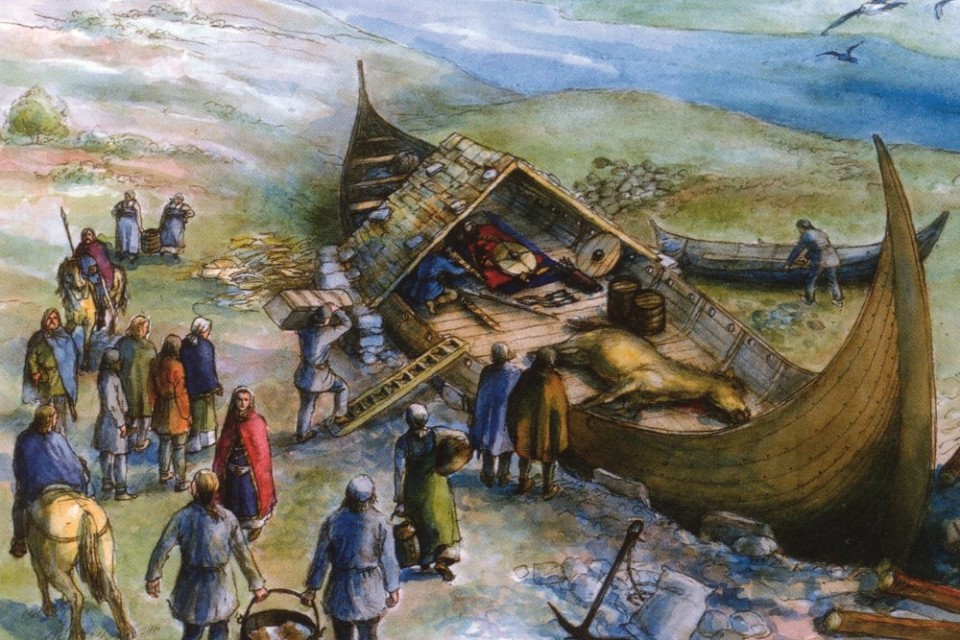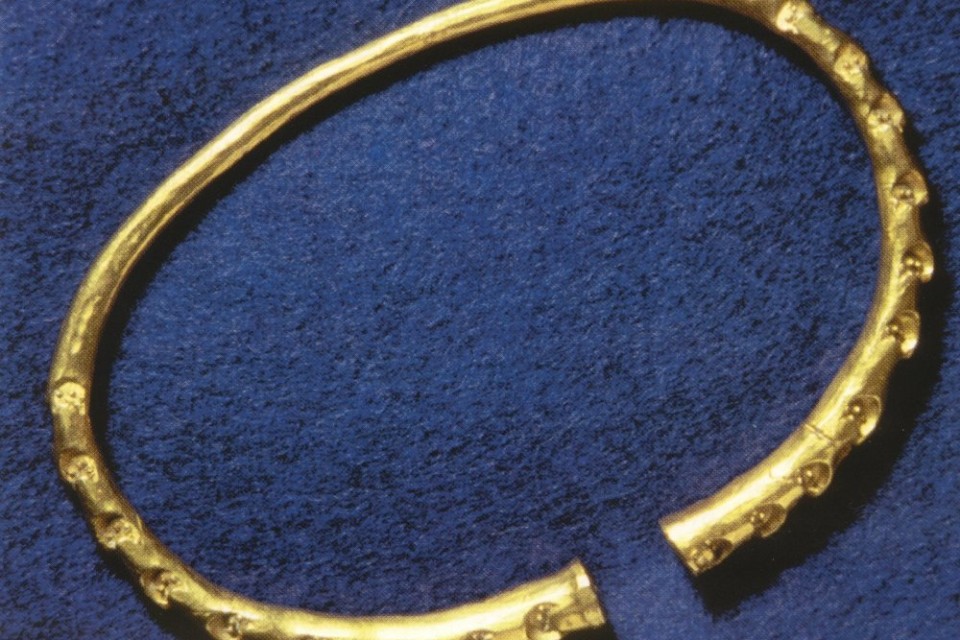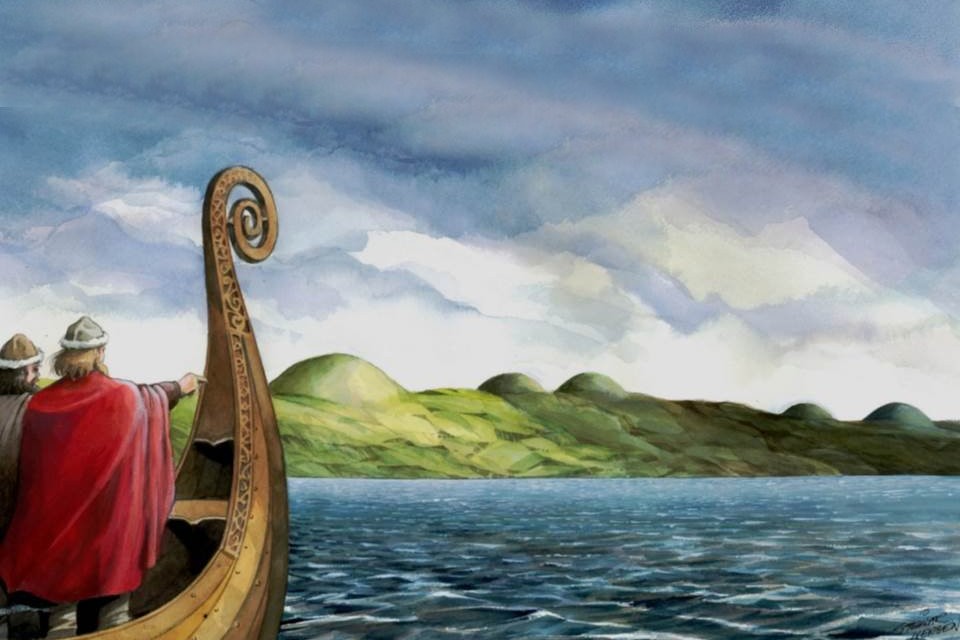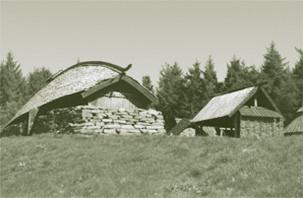King of Great Mound
Text: Marit Synnøve Vea
In the summer of 779, a powerful king was buried in a large ship at Avaldsnes. He was buried with a smaller boat, a sleigh, a horse, weapons, a gold bracelet and many other rich burial gifts.
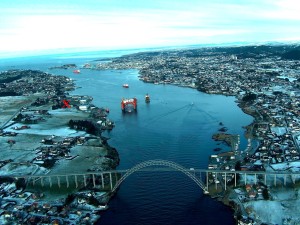
Great Mound (Storhaug) was situated at Gunnarshaug, north of the Royal Manor at Avaldsnes, together with many other large burial mounds that addressed the strait Karmsund. (Photo Gunnar Strøm)
The king of the Great Mound (= Storhaug) had made Avaldsnes the centre of a kingdom in Western Norway, with Rogaland and Sunnhordland at its core.
He founded this kingdom along the lines of the Frankish Empire and he had close contact with the Franks. It was this kingdom that Harald Fairhair conquered or inherited, when he began the unification of Norway.
A divine ancestry gave the right to rule
When a king died, society came under threat. The king was an important part of the glue that kept society together. It was important to ensure cohesion amongst the people and the best possible platform for the new ruler.
People came from far and wide to participate in the essential rituals connected with the burial of a king. It may have been weeks or months before the grave in the Great Mound was closed. For a long time, people sailing through the strait of Karmsundet could look up to the top of the ridge and see the burial ship with the dead king lying in it. Finally, they built an enormous burial mound over the king and his ship. This mound was one of the largest of the many big burial mounds that towered over passers-by on both sides of the strait. It was therefore called the Great Mound.(Storhaug in Norwegian)
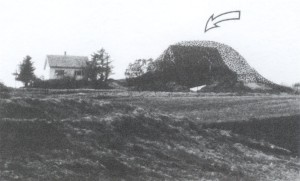
Great Mound (Storhaug) as it must have looked like before the excavation. Great Mound was originally one of Norway’s largest burial mounds, approximately 40-50m in diameter and 5-6m in height. It would have appeared even taller, situated as it was on a small plateau where the Karmsund Strait was at its narrowest. (Photo Jenny Rita Næss, AmS)
Ship’s graves are always aristocratic graves and only 14 such graves have been found in Northwest Europe. The magnificent burial of this king with his ship, horse and gold ring in the Great Mound was a cult ritual which was intended to show that the dead king was descended from the gods. The burial was also carried out to ensure that the blessing of the gods was transferred to the next ruler.
Avaldsnes – the sacred seat of kings
Avaldsnes is associated with ancestral myths about mythological and historically famous kings. Avaldsnes played an important mythological and historical role as the sacred place where kings were traditionally buried.
Was the king of the Great Mound buried at Avaldsnes in order to incorporate a new royal dynasty into this ancient and heroic tradition? Some people believe that Harald Hairfair’s family roots stemmed from Avaldsnes even before the unification of Norway. Or was the king of the Great Mound one of Augvald’s descendants, as most still believe? For there are no written sources that tell us that the Augvald dynasty moved away from Avaldsnes before Harald arrived in around 870.
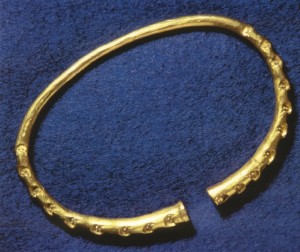
The king in Great Mound (Storhaug) was equipped with an arm ring of gold. Such arm rings are very rare in Viking Age graves. The Flatey Book tells that King Half also had a large ring of gold. (Photo Historisk museum, Bergen)
Who is buried in the Great Mound?(Storhaug)
Over the centuries, people forgot who was buried in the Great Mound. In 2009, when the mound was dendrochronologically dated to 779, we could start to speculate who he was by examining the family lineages in the ancient sagas and what they tell us about the kings who lived at Avaldsnes – even before Harald Hairfair and his unification of Norway.
We are not sure how long each king in these lineages lived. Some names may also have disappeared from the family trees and several people with the same name may have merged into one. Taking these factors into account, there were two men who could potentially be the king of the Great Mound: Hjorleif the woman-lover and Half.
The saga relates that Hjorleif was married to three women at the same time: Åsa the fair from Valdres, Hild the slim from Møre and Ringja, the daughter of the Danish king Reidar. Hjorleif ruled over a kingdom in Rogaland and Hordaland and also conquered a kingdom in Denmark. The story goes that he sailed to Bjarmeland and that he died on a Viking raid.(See Hjorleif the Woman-lover)
Half Hjorleifson was a great hero of his time and one of the sagas is dedicated to him: The Saga of Half & His Heroes. Half and his men sailed the Western Way for 18 years. They fought many battles and were always victorious. The story tells that Half and his men never lowered their sail or sought shelter in a harbour, even if there was a storm, but anchored instead off the outermost tip of land. They used short, single-edged Saxon swords in order to get as close to the enemy as possible. However, it was said that Half and his heroes never abused women or children and that Half instructed his men to bestow gifts on the women they married.
Half succeeded his father Hjorleif as king of Rogaland and Hordaland and his mother Hild married Åsmund, another king of Hordaland. When Half returned home from his raids, he was betrayed by his stepfather who sat fire to the hall where Half and his men were banqueting. It is said that Half laughed as he lay dying. (See Half)
What can the objects in the Great Mound tell us?
The Great Mound ship’s grave is situated at Gunnarshaug, just north of the royal court at Avaldsnes. At one time, there were as many as 13 burial mounds at Gunnarshaug. The Great Mound was excavated in 1886. By that time, farmers had used part of the ship for fuel. But the objects remaining in the grave nevertheless bear witness to a burial of exceptional wealth.
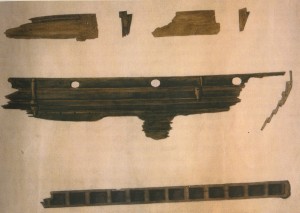
Watercolour of the starboard side of the ship in Great Mound. (Storhaug) Qute from Lorange’s diary: “The top plank (relingsbordet) is significantly thinner than the other ship planks, but in this upper plank the oar holes are placed at one meter from each other. The ship planks are 6 cm thick and 13 cm wide, that is thicker that in the Gokstad ship.” Shetelig says the drawing is misleading because the oar holes are cut down to edge with the upper thick sheer strake. At the bottom you see the gangway. (Photo Svein Skare, Bergen Museum)
The ship
The ship of in the Great Mound was made of oak and very strongly built. The keel was about 22 m, which means that the ship must originally have been at least 27 m long. The gunnels were sturdy and unusually thick: 6 cm. This must therefore have been a seagoing vessel built to withstand rough waters.
The huge ship was placed in a strange stone construction whose meaning we still do not fully understand.
Boat, horse and sleigh
In addition to the large ship, a smaller boat and a horse were buried with the king. Shetelig writes that there were also the remains of a sleigh in the grave. The ship, boat, horse and sleigh were probably placed there to help him reach the realm of the dead.
Arm ring of gold
The king in the Great Mound also had a beautiful arm ring made of gold. Arm rings like this are very rarely found in graves from the Viking Age.
Ancient myths tell us that Odin threw the ring Draupne into Balder’s burial ship. The purpose of the ring was to bestow on Balder the rightful status due to him in the underworld. Balder subsequently sent the ring back to the gods so that the god of love, Frøy, could win for himself the beautiful Gerd, marry her and have children. The ring is therefore the symbol of the sacred circle of birth, death and new birth.
A ring of bronze was also found in the burial

Hnefatafl?
Two sets of board games were found in Great Mound (Storhaug). The counters made of amber were originally 20 pieces. The counters made of glass were distributed as follows: 12 blue, 4 yellow and 1 black. (Photo Bergen Museum)
Two sets of board games
Amongst the burial gifts were two sets of costly board games, one with counters made of amber and the other with counters of blue and yellow glass.
The counters were probably of the type used in the board game called Hnefatafl (Old Norse for “the king’s board”). Hnefatafl was certainly played in Northern Europe and in England from the 8th century and into the Middle Ages. The game is similar to chess, whereby guards aim to defend the king against attackers by bringing him safely into one of the castles on the board.
The skald of Harald relates that Harald’s “quick warriors” play a board game in the yard of the royal court. The Edda poem Voluspå also tells of the gods playing a board game at Idavollen.
Two Frankian swords
There was one single-edged and one double-edged sword in the grave. These may have been a gift from the Frankian king. Pairs of swords similar to this have also been found in aristocratic graves in France dating from this time. In Western Norway, it is very rare to find double-edged swords from the 8th century. Both swords were lying in their scabbards.
The weapon collection we find in the Great Mound can be compared to that of Frankian horse burials and the findings in the Great Mound point to the highest level in the social hierarchy.
Quiver, spear, lance and knife
The quiver is very special: it is made of 24 thin layers of iron rolled together to make a tube, perhaps in order to protect the valuable arrow feathers? On the outside, the quiver was covered with hide, with the hairside laid inwards. Nothing remains of the bow.
Bows and arrows were used for hunting and warfare. The quiver in the Great Mound is so large that it was probably made as a war weapon for a horseman.
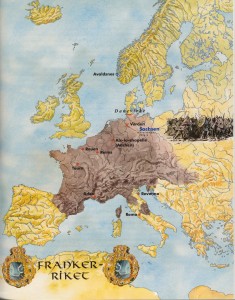
Map showing the Frankian realm (Ill. Dag Frognes)
Woodwork and iron tools
A great deal of woodwork and many objects made of iron were found in the Great Mound. According to Shetelig, some of the wood originally belonged to a sleigh. Many of the iron objects have rusted together and it is difficult to discern what they once were, but it appears that some of them were tools that a blacksmith would have used.
Strange objects
Two inexplicable objects were found in the Great Mound. One is a wax cake with the symbol of a Christian cross pricked into its surface. The Great Mound is a pagan grave, but can this cross be a sign of Christian influence as early as the late 8th century? The other strange object was a feather inside a tin. What was so special about this feather that it had to be placed in a tin? Was it a quill? Had the King of the Great Mound learnt to write?
Was the king in the Great Mound an ally of the king of Frankia?
The grave in the Great Mound was a sumptuous grave for a time when graves usually had been simple and poorly equipped. This would indicate that a new kingdom had been established and that a small number of rulers had acquired great power to the detriment of others.
The burial gifts in the Great Mound, exemplified by two beautiful Frankian swords, point to close contact with the Franks. Perhaps these swords were a gift from the king of Frankia?
The Franks needed allies in the North
New and large trading posts were established during the 8th century. The trade routes leading northwards from the Continent were becoming much more important, included the so-called Nordvegen (“way to the North”) along the coast of Western Norway to Northern Norway.
Goods from Northern Norway and from the mountains were valuable and all of them had to be transported via Avaldsnes. Perhaps the rulers at Avaldsnes levied custom duties on all goods that passed through on their way to the major trade centres on the Continent? The Franks needed goods that Norway could provide and therefore needed allies in the North.
The Frankish Empire – the new major power in Europe
The Franks took over as the new major power in Europe during the 8th century. This must have influenced many small kings, encouraging them to form larger kingdoms inspired by the Frankian model.
-
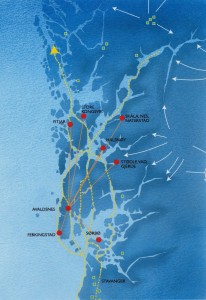
THE KING’S ROYAL FARMS • Places that seem to have Royal Manor functions in the 8th century (After Opedal 1998)
¤ Male graves with horse equipment. (After Meling 2000)
••••Communication routes in the Iron Age (After Elvestad 2005, 2007)
→ Important mountain passes (After Ringstad 1987)
Kingdoms bound together by ties of loyalty between chieftains
In Norway, the king of the Great Mound was a ruler who probably was inspired by the Franks to form a larger kingdom. Kingdoms were bound together by ties of loyalty between chieftains, not by geographical borders as in our time, and these alliances were sanctioned by gifts in the form of rings, horses and weapons.
Graves with horses and equestrian equipment – signs of the king of the Great Mound’s warrior aristocracy?
In Western Norway, we find graves with horses and riding equipment. On the Continent, graves of this kind were connected to a warrior aristocracy and a growing centralisation ratified by gifts and alliances.
The map shows the contours of a network of alliances between Avaldsnes and the surrounding regions. Perhaps the men laid in these graves belonged to the warrior aristocracy of the king of the Great Mound.
Rich findings dating from the same time as the Great Mound have been discovered on farms in the area around Avaldsnes. We believe that these were royal courts which, together with Avaldsnes, made up the core of the new kingdom.
Did Harald Hairfair inherit or conquer these royal courts?
Avaldsnes, Fitjar and Skåla (Kvinnum?) were the royal courts of Harald Hairfair after unification at the end of the 9th century. The other large farms on the map probably also had ties with the kingdom.
The core of Harald Hairfair’s kingdom was probably already established and in operation by the 8th century. Did the legendary Harald conquer an ancient kingdom here after the Battle of Hafrsfjord? Or was Harald Hairfair the heir to this kingdom, which he used as a starting point for the unification of Norway?
Back

